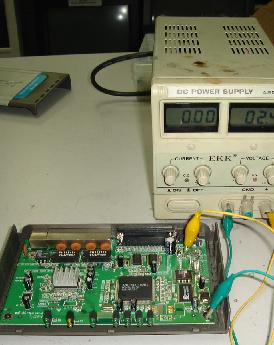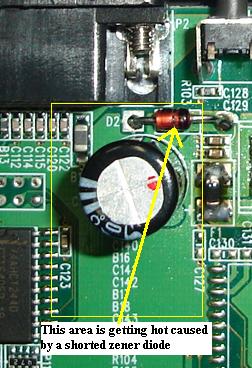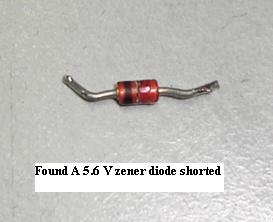How To Repair Short Circuit In Ethernet Broadband Router
Recently my company D-link Ethernet broadband router broke down and I can’t access the internet. The problem was no power but there was 5 volts output from the power adapter, so this proof that the router itself not working. As usual we as electronic repairer do not buy any new equipment unless we have inspected the equipment our self. If we found that the equipment is beyond repair such as lightning strike or no spare parts then only we give up and buy a new unit.
Upon opening up the cover I didn’t see any signs of lightning strike, burn components or even bulged capacitors. The main board looks perfectly okay. Now the next step that I took was to plug in the 5 volt supply voltage to the input jack and analyze why the LED’s do not lit. Surprisingly the moment 5 volts supply was plugged it in, the 5 volts immediately dropped to 0 volts. I thought it could be the regulation problem in the power adapter so I took out a 12 volt automobile light bulb from my toolbox and connect it to the output jack. The bulb lit and when checks with a digital meter it showed exactly 5 volts! This again proven that the power adapter is working perfectly fine.
My concentration now was in the main board because the power adapter was not the cause of no power in the router. Since the main board was pulling down the power supply voltage, I presumed that there must be something that have direct short between the supply line and ground. Using my analog meter set to X 1 ohm, I placed the red probe to ground and the black probe to the supply line and shifted the probes again, I could clearly noticed that the analog meter pointer both the reading points to very low ohm (zero ohms indicated short circuit).
Because of so many components that have connection with the supply lines, I really do not know as which one is the culprit. Shorted IC’s, capacitors, diodes, zener diodes, transistor and etc can cause the supply line to have direct connection with the ground. Do not worry as there is an easy way to isolate this type of problem. Remember the newsletter repair article mentioned about how to detect short circuit with the help of a regulated power supply? Yes, I’m going to use it to locate the cause of the short circuit too. First connect the negative from the regulated power supply to the main board ground and the positive to the supply line of the main board. Now slowly increase the voltage of the regulated power supply by turning the variable resistor. If there is a short circuit present, the ampere or current drawn would be great and you could see it from the regulated power supply LCD panel.
In my case, yes the current drawn is proportional to the voltage increment. The higher the voltage the higher the current drawn and it is abnormal. Even before the voltage reached 2 volts (suppose it should be tune to 5 volt), the current already increased to few amps! I stopped at 2 volts and begin to inspect the main board to see if there is any sign of warm components. If you could locate one then that is the shorted component that pulled down the 5 volt supply voltage.
Usually I would suspect IC’s first but all the IC’s looks cool only. Then I began to touch on other components. While my finger browsing the supply input area I found that the circuit board was extremely hot. The hot area only consists of electrolytic capacitor, a zener diode and few other components. I switched off the regulated power supply and checked one by one of the components in that area. Electrolytic capacitor checked to be good and the real caused of the problem was the zener diode. The zener diode had developed a short circuit. The marking of the zener diode was 5V6 which means 5.6 volt. After replaced the zener diode and checked with analog meter again, there were no more short circuits and the router’s power came back once the power adapter jack was plugged in.
In this article, the method that I have shown you above can be apply to any kind of electronic boards that have short circuit between the supply line and the ground. You just have to be creative in electronic troubleshooting and who knows one day you may end up of discovering some new methods in solving electronic problems fast, easy and eventually save your precious repair time.
|
|
Copyright@ 2006-2014-www.ElectronicRepairGuide.com All Rights Reserved




